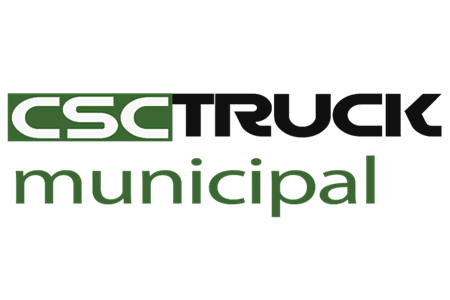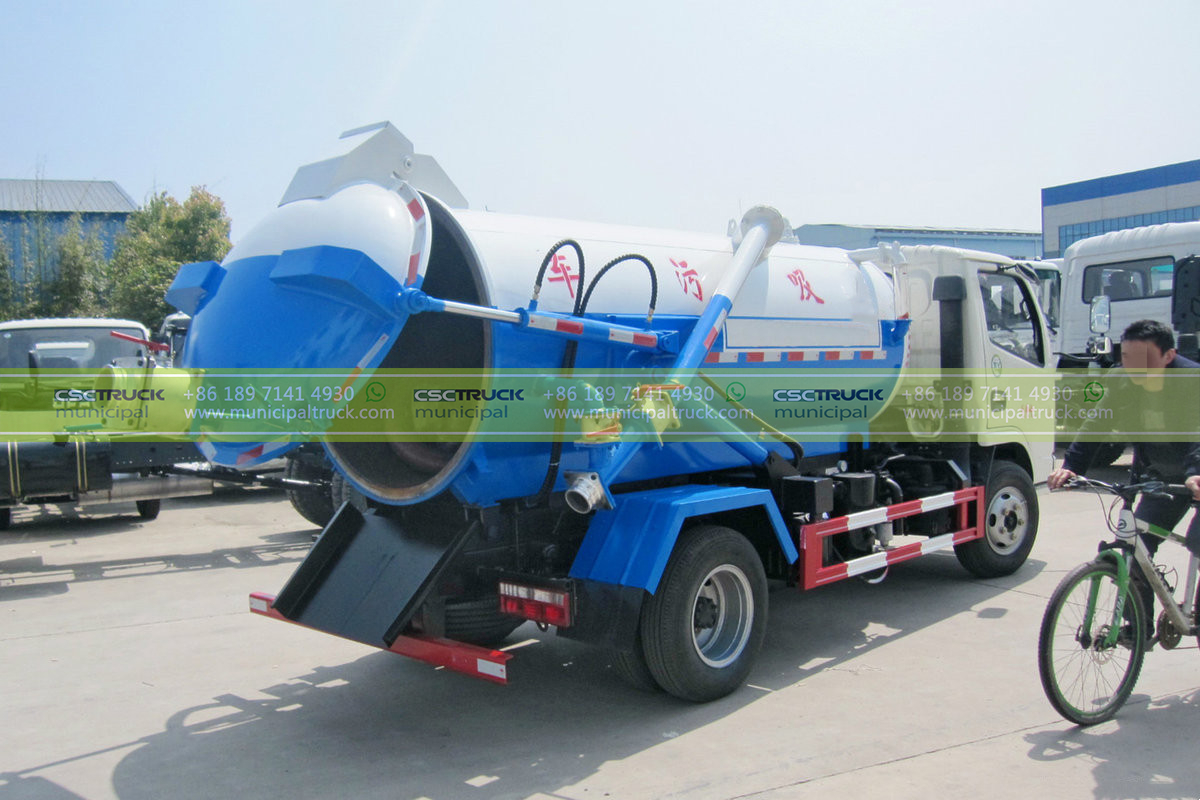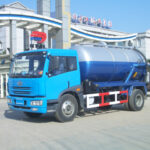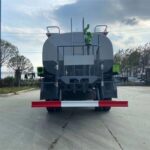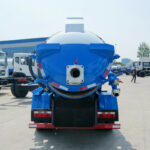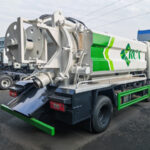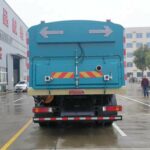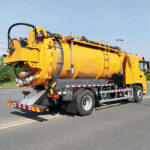1. The Physics of Destruction: Ultra-High-Pressure Dynamics
Transforming Water into a Cutting Torch
Water jetting trucks harness hydrodynamic cavitation to generate pressures exceeding 40,000 PSI – a force capable of shearing through reinforced concrete and dissolving molecular bonds in industrial residues. The destruction mechanism operates through three simultaneous phenomena:
- Micro-Impact Fracturing: Abrasive particles (garnet, olivine) accelerated to supersonic velocities create microfractures in concrete matrices at 2,500 impacts per square inch per second
- Boundary Layer Disruption: Turbulent flow patterns peel hardened residues from substrates by exploiting microscopic imperfections in adhesion
- Thermal Shock Cycling: Rapid temperature fluctuations induced by pulsed jets (cycling between 4°C and 95°C) fatigue materials beyond tensile limits
Unlike mechanical demolition, this non-thermal cutting process prevents hazardous dust generation and structural vibration. When the Port of Hamburg faced 800 cubic yards of dried concrete spillage blocking cargo bays, twin-jet systems achieved complete removal in 53 hours without disrupting adjacent robotic warehouse operations – a feat impossible with jackhammers or chemical dissolvers.
2. Concrete Spill Emergencies: Specialized Response Protocols
Scenario-Based Tactical Approaches
Fresh Spill Neutralization (0-90 Minutes)
For liquid concrete containment, jetting trucks deploy immediate viscosity interruption protocols:
- Surface Tension Breakers: Phospholipid-based surfactants sprayed at 600 GPM prevent hydration bonding
- Laminar Flow Extraction: Low-pressure (800 PSI) vacuum-assisted suction removes slurry before setting
- Substrate Preservation: Cryogenic nozzles cool rebar to delay thermal transfer during cleanup
Hardened Concrete Remediation
Crystalline matrix penetration requires strategic sequencing:
- Patterned Fracture Initiation: Diamond-tipped nozzles create stress points at 10cm intervals
- Delamination Wave Propagation: Oscillating jets (15-25Hz frequency) amplify microfractures
- Reactive Debris Management: Simultaneous vacuum recovery captures 98% of aggregate
The 2023 Istanbul Metro tunnel breach saw jetting units remove 27 tons of cured concrete from active rail systems in 41 hours using adaptive pressure modulation – automatically adjusting from 36,000 PSI for rebar exposure to 8,000 PSI for delicate tile restoration.
3. Industrial Residue Eradication: Chemical-Free Decontamination
Molecular Bond Targeting Strategies
Petrochemical Sludge Systems
Hydrocarbon chain dissociation leverages thermochemical resonance:
- Paraffin Waxes: 190°F heated jets trigger crystalline phase transition to liquid
- Asphaltenes: Pulsing frequencies match carbon-ring resonant frequencies (12-18kHz)
- Pyrophoric Residues: Oxygen-depleted nano-bubbles prevent ignition during tank cleaning
Polymer Production Waste
Cross-linked polymer dissolution requires precision:
| Resin Type | Pressure Profile | Abrasive Media |
|---|---|---|
| PVC | 22,000 PSI pulsed | Calcium carbonate |
| Silicones | 34,000 PSI continuous | Aluminum oxide |
| Epoxies | 28,000 PSI + 80°C | Recycled glass |
Taiwanese semiconductor fabs utilize robotic jetting arms with Raman spectroscopy feedback, autonomously adjusting parameters when detecting residual fluoropolymer traces in exhaust ducts.
4. Cutting-Edge Hydroblasting Platforms
Next-Generation System Architecture
Dual-Pump Vector Systems
Kärcher’s HDS 1000 DE features parallel pumps delivering:
- Primary Stream: 8.6 GPM at 40,000 PSI for cutting
- Secondary Envelope: 15 GPM at 2,000 PSI containing debris plume
- Virtual Containment Field reduces cleanup water by 83% versus traditional systems
Intelligent Nozzle Arrays
Rotating multi-orifice heads with machine vision:
- Automatically detect material hardness variations
- Adjust jet convergence angles from 5° to 25°
- Switch abrasives mid-operation via pneumatic media gates
The automated surface profiling in BASF’s Ludwigshafen facility achieves Sa 2.5 cleanliness standards in half the time of manual blasting while mapping residual contamination to 50-micron accuracy.
5. Environmental & Safety Engineering
Sustainable Contaminant Management
Closed-Loop Hydroblasting transforms waste streams:
- Debris Classification: Hydrocyclones separate solids >75 microns
- Emulsion Breaking: Electrocoagulation tanks split oil/water
- Water Reclamation: Ceramic ultrafiltration achieves NSF/ANSI 350 reuse certification
Hazard Mitigation Innovations include:
- Acoustic Leak Detection: Fiber-optic sensors pinpoint hose failures 0.3 seconds post-rupture
- Low-Noise Eductor Systems: Reduce operational decibels from 125 dB(A) to 82 dB(A)
- Anti-Microbial Hosing: Silver-ion impregnated lines prevent biofilm accumulation
Caltrans highway crews now achieve zero discharge compliance during bridge decontamination through integrated polymer flocculation units that transform slurry into dewatered cakes for cement kiln recycling.
6. Municipal Ecosystem Integration
Multi-Role Fleet Optimization
Forward-thinking public works departments configure water jetting trucks as seasonal force multipliers:
- Monsoon Response: Configured with vacuum debris pumps, units clear storm drains 10x faster than conventional rodding crews while capturing 98% of sediments for proper disposal
- Winter Operations: Heated undercarriage kits melt ice from snowplow routes using recovered thermal energy from the pressure pump
- Infrastructure Renewal: Precision hydro-demolition heads selectively remove degraded concrete around rebar for bridge restoration
The true strategic advantage emerges when integrated with companion assets:
- Post-concrete removal, sweeper trucks with magnetic brooms capture metallic residues
- Final rinsing operations transfer to sprinkler trucks equipped with neutralizing agents
- All data streams feed municipal digital twin platforms through IoT-enabled municipal truck fleets
Portland’s Bureau of Environmental Services now achieves 360° infrastructure maintenance by deploying jetting units as mobile inspection platforms – their LIDAR-equipped booms simultaneously clean and map sewer condition while AI algorithms predict future failure points. This operational convergence transforms reactive cleanup into predictive infrastructure stewardship where every gallon of water yields triple-value: cleansing today’s spills, preventing tomorrow’s overflows, and informing next decade’s capital planning.
